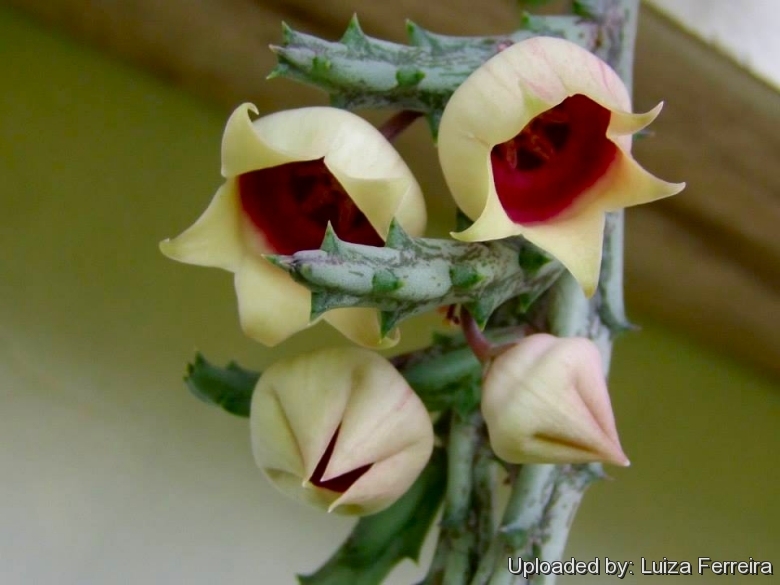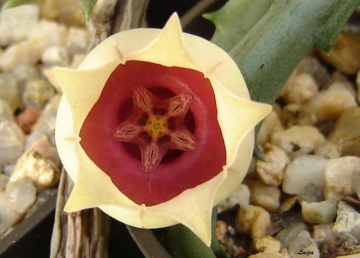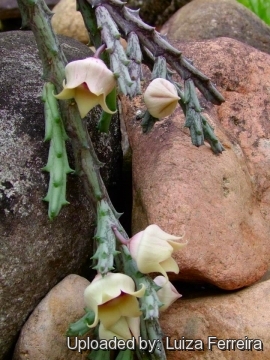




Your support is critical to our success.
Cact. Succ. J. (Los Angeles) 10: 69. 1938
Family: ASCLEPIADACEAE
Accepted Scientific Name: Orbeanthus conjunctus (A.C.White & B.Sloane) L.C.Leach
Excelsa Taxon. Ser. 1: 73. 1978

Origin and Habitat: Orbeanthus conjunctusSN|30507]]SN|30507]] is widely distributed and common in the Soutpansberg and the Blouberg (Limpopo), South Africa. This unusual stapeliad was discovered by a Barclay Bank official, Albert Henry Crundall on the hills west of Mara, it to the west of Louis Trichardt before 1938, Roy Bayliss located it in 1961 on cliffs above the riverbed near the tunnels on the main road through Wyllie's Poort.
Altitude range: 900-1600 metres above sea level.
Habitat and ecology: Orbeanthus conjunctusSN|30507]]SN|30507]] is a cliff, near-endemic, species that grows among leaf litter on ledges of steep rock high up on mountain.
Synonyms:
- Orbeanthus conjunctus (A.C.White & B.Sloane) L.C.Leach
- Orbea conjuncta (A.C.White & B.Sloane) Bruyns
- Stultitia conjuncta A.C.White & B.Sloane
Description: Orbeanthus conjunctusSN|30507]]SN|30507]] is a creeping, perennial, succulent species with greyish-green, mottled stems. The very interesting cupular (cup-shaped) flowers are constricted towards the base by a crimson annulus, the upper portion of the tube and the corolla lobes are flesh coloured. There are quite a few forms of this species, some has rather large and very fleshy flowers up to 5 cm across, so not a small flower. This plant started life as Stultitia conjucta, then Orbeanthus conjunctusSN|30507]]SN|30507]], now settled by some into Orbea conjunctaSN|30509]]SN|30509]].
Stems: Procumbent, grey-green, blotched with dark brownish-green, to 15 (or more under cultivation) cm long, approx 8 mm in diameter. Tubercles 1-2 mm long, conical, to 1.6 cm apart.
Inflorescences: 1-2-flowered successively developed near the base of the stems.
Flowers: Flower buds brownish-green, 4 long, 2 mm wide, ovoid, glabrous. Peduncles brown-green, up to10 long, c 3 mm in diameter. Sepals c. 5 mm long. Corolla variable in size 20-33 mm long, 22-42 mm broad, semiglobose or campanulate, outside whitish-cream with pink, base of the lobes laterally with triangular yellowish areas, inside pale maroon. Tube 5 mm deep, c. 14 mm in diameter, mouth partly cream-coloured, narrowed by the annulus, 8 mm in diameter, more or less 5-angled, fleshy, cup-shaped. Corolla lobes flesh coloured, 3 (or more) mm long and approx 10 mm wide, in the outside furrowed for 6 mm at the base. Corona about 8 mm in diameter. Outer corona lobers dark maroon, stippled with white, deeply bowl-shaped, lobes 3 mm, elongate-rectangular, erect, bifid down to half of tips divergent, flattened, velvety and densely finely pubescent or finely setulose. Hairs shining, usually translucent, uncoloured, very short, nearly spine-like. Attenuate. Inner corona upper half, purple, lower hals white. blotched with purple, lobes ovate, flat, rarely ascending above the style head, dorsally humped, velvety densely finely pubescent, the longest hairs dark purple; Anthers pale yellow. Poll yellow, almost translucent, 0.5 - 0.7 x 0.45 - 0.6 mm. The only slightly foetid smell of the flowers attracts large numbers of different flies from a distance to assist in the pollination. When the potential pollinators are closer to the flowers the vibratile hairs which dangle in the slightest breeze, draw further attention by their movement. These mechanisms sometimes mislead the flies to such an extent that they lay their eggs on the flowers – probably believing that they may be a source of food for their hatched maggots.
Fruits: The fruit are paired spindle-shaped capsules (follicles), resembling the horns of an antelope, with the tightly packed seeds inside. At maturity they split open to release numerous small brown seeds crowned with long white hairs.
Bibliography: Major references and further lectures
1) Victor, J.E. & Hahn, N. 2005. Orbea conjuncta (A.C.White & B.Sloane) Bruyns. National Assessment: Red List of South African Plants version 2014.1. Accessed on 2015/02/14
2) Focke Albers, Ulrich Meve “Illustrated Handbook of Succulent Plants: Asclepiadaceae: Asclepiadaceae” Volume 4 Springer Science & Business Media, 2002
3) Doreen Court “Succulent Flora of Southern Africa” CRC Press, 01 June 2000

Stultitia conjuncta (Orbeanthus conjunctus) Photo by: Luiza Ferreira

Stultitia conjuncta (Orbeanthus conjunctus) Photo by: Luiza Ferreira
Cultivation and Propagation: Orbeanthus conjunctusSN|30507]]SN|30507]] is a very unusual, seldom offered, xerophytic plant adapted to dry soils and not difficult as commonly supposed only bearing in mind that this species benefits from slightly warmer winter than others. Species like Orbeanthus hardyiSN|30507]]SN|28306]] and Orbeanthus conjunctusSN|28306]]SN|30507]] do well in hanging baskets and shady areas.
Growth rate: It is a somewhat difficult and slow growing Stapeliad that will make large clumps given the best conditions. Most plants will offset readily, and clumps can be produced in a few years.
Soils: It likes very porous mineral cactus mix soil, pH 7,5 to 8,5 (mildly alkaline), but can become too elongated if compost is too rich.
Repotting: This plant needs plenty of space for its roots, repotting should be done every other year or when the it has outgrown its pot. Use pot with good drainage.
Watering: It needs regular watering, especially during the hottest summer days; provide also some light watering if the green house temperatures in winter are elevated. Either excessive or very scarce watering can induce rot.
Fertilization: Feed with a high potassium fertilizer in summer.
Frost Tolerance: For safe cultivation winter temperatures must be kept over 10° C, but it can withstand winter night-time temperatures down to about 5°(or less) Celsius for short period. Freezing temperatures are often fatal. In the rest period no high atmospheric humidity!!
Sun Exposure: Best for half-shade but grow well in full sun and full shade too. Tends to bronze in strong light, which encourages flowering, but is likely to suffer from sun scorch or stunted growth if over exposed to direct sunlight during the hottest part of the day in summer.
Diseases: This species is relatively resistant to cryptogamic diseases than others and is quite resistant to the “Balck spot” disease of Asclepiads. Rot it is only a minor problem with Orbeanthus conjunctusSN|30507]]SN|30507]] if the plants are watered and “aired” correctly. If they are not, fungicides won't help all that much.
Uses: It is an excellent plant for container growing. Cascading, clustering, great for a hanging display. Stems may possibly become purple and limp in winter, but revitalize in early spring. It always looks good and stays small. It look fine in a cold greenhouse and frame or outdoor in a rockery.
Propagation: Seeds and cuttings. Cuttings will root only in hot weather. Cuttings must be kept very dry to root. Seeds germinate readily if they are sown when fresh.
| Your Actions | |
|---|---|
| Back to Stultitia index | |
| Back to Asclepiadaceae index | |
 |
Back to Succulents Encyclopedia index |
Privacy stantement - Terms and conditions - How to cite - About us - Feedback - Donate



